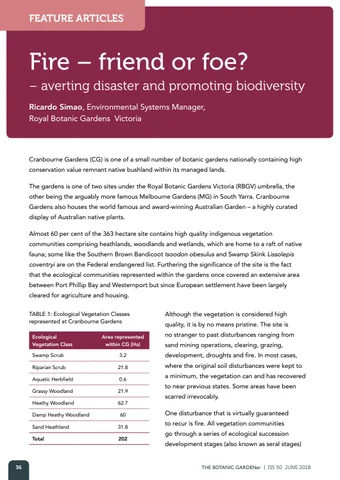FEATURE ARTICLES
Fire – friend or foe? – averting disaster and promoting biodiversity Ricardo Simao, Environmental Systems Manager, Royal Botanic Gardens Victoria
Cranbourne Gardens (CG) is one of a small number of botanic gardens nationally containing high conservation value remnant native bushland within its managed lands. The gardens is one of two sites under the Royal Botanic Gardens Victoria (RBGV) umbrella, the other being the arguably more famous Melbourne Gardens (MG) in South Yarra. Cranbourne Gardens also houses the world famous and award-winning Australian Garden – a highly curated display of Australian native plants. Almost 60 per cent of the 363 hectare site contains high quality indigenous vegetation communities comprising heathlands, woodlands and wetlands, which are home to a raft of native fauna; some like the Southern Brown Bandicoot Isoodon obesulus and Swamp Skink Lissolepis coventryi are on the Federal endangered list. Furthering the significance of the site is the fact that the ecological communities represented within the gardens once covered an extensive area between Port Phillip Bay and Westernport but since European settlement have been largely cleared for agriculture and housing. TABLE 1: Ecological Vegetation Classes represented at Cranbourne Gardens Ecological Vegetation Class
quality, it is by no means pristine. The site is no stranger to past disturbances ranging from sand mining operations, clearing, grazing,
Swamp Scrub
3.2
development, droughts and fire. In most cases,
Riparian Scrub
21.8
where the original soil disturbances were kept to
Aquatic Herbfield
0.6
Grassy Woodland
21.9
Heathy Woodland
62.7
Damp Heathy Woodland
36
Area represented within CG (Ha)
Although the vegetation is considered high
60
Sand Heathland
31.8
Total
202
a minimum, the vegetation can and has recovered to near previous states. Some areas have been scarred irrevocably. One disturbance that is virtually guaranteed to recur is fire. All vegetation communities go through a series of ecological succession development stages (also known as seral stages)
THE BOTANIC GARDENer | ISS 50 JUNE 2018


